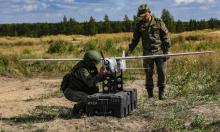NASA rover's performance on Mars
The space agency had allocated about 24 hours across four sols, or Martian days, for the transplant. But uploading files to the rovers ultimately took less time than needed - about 16 hours over three sols.
"The rovers are in really good shape healthwise, and the deep sleep mode for Opportunity allows us to conserve energy rather than using it on the heater," said Jan Chodas, flight software manager for the project and an employee of the California Institute of Technology's Jet Propulsion Laboratory. "As the mission goes on, Mars moves away from the sun and the energy available each day drops. So it's more important to conserve energy to run the rover everyday. This enables more data gathering."
A sol is 40 minutes longer than an Earth day, inform fcw.com
The discovery of Bounce raises the distinct possibility that life arising from a common source could have existed for a time on both worlds.
The way Opportunity's luck has been going, it would not be surprising to learn the rover has detected Martian microbes.
Not only did NASA's rover land smack-dab in the middle of a neatly excavated and navigable crater on Mars, where it promptly uncovered persuasive evidence that water once flowed across the red planet, and not only has it been performing nearly flawlessly since it touched down on Jan. 24. Now, it also, essentially, has stubbed its toe on a rock whose discovery portends cosmic implications.
A few days ago, on its slow roll across the Martian terrain at its landing site at Meridiani Planum, an iron-oxide-rich area near the planet's equator, Opportunity's controllers noticed an odd-looking, football-shaped rock lying in the red dust. They named the rock "Bounce," because the lander most likely hit it as it bounced along the surface, cushioned by its airbags, before coming to rest inside the little crater called Eagle.
Controllers considered Bounce an odd find because it did not resemble any of the other rocks in the crater's vicinity -- nor did it resemble anything seen before on Mars, they said.
So they ordered Opportunity to train its formidable instruments on the rock, including the tool NASA engineers affectionately called the "RAT," for rock abrasion tool, which grinds away surface impurities to expose the undisturbed, primordial composition below, report upi.com
According to nwsource.com the extra mission begins May 1, but the transition is well under way. Planners have found $15 million in additional funding, started software upgrades for the rovers and put scientists on Earth time after three exhausting months of round-the-clock - Mars clock - staffing.
They have also chosen new targets to explore. After a mostly uneventful sojourn at Gusev Crater, Spirit is embarked on a 0.9-mile drive to a highland known as Columbia Hills, where planners hope to find rock outcrops that will provide new insights into Mars' geologic history.
Opportunity, meanwhile, has begun a 750-yard traverse to the edge of a crater dubbed Endurance. There scientists hope to find as much as 100 feet of exposed rock that could offer fresh clues about the extent of an ancient salt sea whose traces Opportunity discovered only a few yards from its landing site on Meridiani Planum.
Subscribe to Pravda.Ru Telegram channel, Facebook, RSS!





